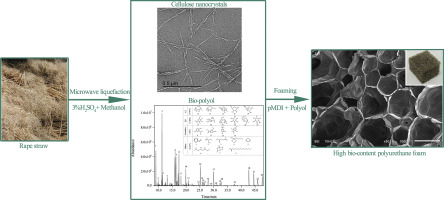当前位置:
X-MOL 学术
›
Mater. Des.
›
论文详情
Our official English website, www.x-mol.net, welcomes your
feedback! (Note: you will need to create a separate account there.)
High bio-content polyurethane (PU) foam made from bio-polyol and cellulose nanocrystals (CNCs) via microwave liquefaction
Materials & Design ( IF 7.6 ) Pub Date : 2018-01-01 , DOI: 10.1016/j.matdes.2017.10.058 Xingyan Huang , Cornelis F. De Hoop , Jiulong Xie , Qinglin Wu , Dorin Boldor , Jinqiu Qi
Materials & Design ( IF 7.6 ) Pub Date : 2018-01-01 , DOI: 10.1016/j.matdes.2017.10.058 Xingyan Huang , Cornelis F. De Hoop , Jiulong Xie , Qinglin Wu , Dorin Boldor , Jinqiu Qi

|
Abstract In this work, both the bio-polyol and cellulose nanocrystals (CNCs) used to produce high bio-content polyurethane (PU) foams were prepared from microwave liquefaction of rape straw. As high as 40% petro-based polyol was replaced by bio-polyol and the bio-foams containing 40% bio-polyol (PU40) were further reinforced by incorporating 1 to 6% CNCs. GC–MS, 1H NMR and FTIR observations demonstrated that the bio-polyol is a hydroxyl-rich source consisting of C5, C6 sugars and aromatics. The maximum physico-mechanical performance of bio-foam without CNCs was observed from the bio-foam containing 20% bio-polyol. When further increasing bio-polyol content from 20 to 40%, these properties dramatically decreased. This result was possibly due to the complex polyurethane crosslinking reactions with C5, C6 sugars and aromatics. As compared with reference (PU40), the Young's modulus and compressive stress in the optimal 4% CNCs reinforced bio-foam increased by 590% and 150%, respectively. It was noteworthy that these values were highly superior to those of the petro-based foam. Solid state 13C NMR and FTIR analysis of CNC reinforced bio-foam evidenced that the hydroxyl-rich structure in CNCs participated in the cross-linking reactions, resulting in an increase of the polyurethane crosslinking density, which contributes to the increased physico-mechanical performance of bio-foam.
中文翻译:

通过微波液化由生物多元醇和纤维素纳米晶体 (CNC) 制成的高生物含量聚氨酯 (PU) 泡沫
摘要 在这项工作中,通过微波液化油菜秸秆制备了用于生产高生物含量聚氨酯 (PU) 泡沫的生物多元醇和纤维素纳米晶体 (CNCs)。高达 40% 的石油基多元醇被生物多元醇取代,含有 40% 生物多元醇 (PU40) 的生物泡沫通过加入 1% 至 6% 的 CNC 得到进一步增强。GC-MS、1H NMR 和 FTIR 观察表明,生物多元醇是一种富含羟基的来源,由 C5、C6 糖和芳烃组成。从含有 20% 生物多元醇的生物泡沫中观察到没有 CNCs 的生物泡沫的最大物理机械性能。当进一步将生物多元醇含量从 20% 增加到 40% 时,这些特性会急剧下降。这一结果可能是由于聚氨酯与 C5、C6 糖和芳烃的复杂交联反应。与参考(PU40)相比,最佳的 4% CNCs 增强生物泡沫的杨氏模量和压缩应力分别增加了 590% 和 150%。值得注意的是,这些值远远优于石油基泡沫的值。CNC 增强生物泡沫的固态 13C NMR 和 FTIR 分析证明,CNC 中富含羟基的结构参与了交联反应,导致聚氨酯交联密度增加,这有助于提高其物理机械性能。生物泡沫。
更新日期:2018-01-01
中文翻译:

通过微波液化由生物多元醇和纤维素纳米晶体 (CNC) 制成的高生物含量聚氨酯 (PU) 泡沫
摘要 在这项工作中,通过微波液化油菜秸秆制备了用于生产高生物含量聚氨酯 (PU) 泡沫的生物多元醇和纤维素纳米晶体 (CNCs)。高达 40% 的石油基多元醇被生物多元醇取代,含有 40% 生物多元醇 (PU40) 的生物泡沫通过加入 1% 至 6% 的 CNC 得到进一步增强。GC-MS、1H NMR 和 FTIR 观察表明,生物多元醇是一种富含羟基的来源,由 C5、C6 糖和芳烃组成。从含有 20% 生物多元醇的生物泡沫中观察到没有 CNCs 的生物泡沫的最大物理机械性能。当进一步将生物多元醇含量从 20% 增加到 40% 时,这些特性会急剧下降。这一结果可能是由于聚氨酯与 C5、C6 糖和芳烃的复杂交联反应。与参考(PU40)相比,最佳的 4% CNCs 增强生物泡沫的杨氏模量和压缩应力分别增加了 590% 和 150%。值得注意的是,这些值远远优于石油基泡沫的值。CNC 增强生物泡沫的固态 13C NMR 和 FTIR 分析证明,CNC 中富含羟基的结构参与了交联反应,导致聚氨酯交联密度增加,这有助于提高其物理机械性能。生物泡沫。











































 京公网安备 11010802027423号
京公网安备 11010802027423号